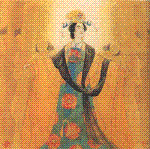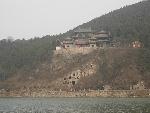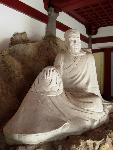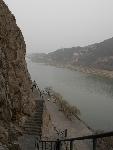- Getting around Lijiang. Dont stay in the Old Towns more than 2 days, there is nothing to do. KRISS Oct 9, 2013 05:46
- 2013 Beijing Temple Fair BENNYLAU Feb 26, 2013 03:29
- Malaysian traveling from KUL - LAX vis Shanghai PVG ZATI_DY Jan 3, 2013 20:15
The Rocks that Inspired Poets and an Empress
- Views: 5461
- |Vote: 0 0
- |Add to Favorites
- |Recommend to Friends
Remarkable Features
She gazes down from her height more than ten times taller than a normal human, her gaze keeps sentinel on water funneling through this narrow passage, the Dragon’s Gate, bedrock of theYellow River basin: birthplace of Chinese civilization. Her physical size parleys a metaphor for her metaphysical height; a testament to the aspirations of Enlightenment: expand your worldview—not just in scope but also in depth—through the ages.
The sculptors at Longmen Grottoes used real-life sources as inspiration for the lives they etched into stone. But for the Vairocana Buddha at Fengxian Grotto, Longmen’s largest signature site, not just any inspirational figure would do.
Though many assume Buddhist figures to be carved in the likeness of men, the Vairocana Buddha differs in this as with many things. Appearing slightly androgynous, experts attribute the Buddha’s benevolent gaze and softened features not only to enlightenment but to femininity. Similar to the figure seated to Christ’s right in Da Vinci’s The Last Supper, the Buddha’s modest appearance trumps the breadth of her power, though she will be remembered for centuries after as the first—and only—Empress of China.
Masterful Rendering
At the time Fengxian Grotto was commissioned Wu Zetian was newly wed to Emperor Gaozhong, who initiated and commissioned several of the Tang Dynasty Grottoes at Longmen. The Empress—then just First Concubine—used her own savings, known as her ‘cosmetic allowance’ to commission Fengxian Grotto. It wasn’t until 15 years after the Grotto was completed that Wu Zetian ascended as Empress when her husband and sons died.
The style of sculpting at the time Wu Zetian commissioned the Grotto had, up until that point, been largely uniform. But sculptors in the Tang Dynasty developed their art so intimately that they mastered not only perspective (giving appropriate proportions to gigantic statues that would eternally be viewed from below) but also human likeness. Instead of creating a farce of life from stone, the sculptors imbued a frieze of life into the stone.
Nobody appreciated this more than the intrepid Wu Zetian. Ardent patron of the arts, the Dynastic Madame de Rambouillet spent years across the Yi River’s sage ribbon, high in the ramparts of Xiang Shan (Fragrant Mountain) Temple, watching and witnessing the stilettoed tattoo of the cliffsides opposite.
Sweet Fragrance
XiangShan Temple was built in 516 AD to house the monks who had come to Longmen to oversee the stone carvings. The temple was rebuilt in 687 AD by the Imperial court as a sacred burial place to honor the Indian monk and ascetic Dipokeluo. It is a mystery why Dipokeluo stayed at Longmen, corseted by cliffs, though perhaps he came as a master artist bearing knowledge of techniques used in the original Buddhist caves of India. What is certain is that he witnessed the height of Longmen carving, perhaps even the completion of Fengxian Grotto. The temple is a prime location for overseeing the evolution of artwork across the River. Perched high on the Eastern mountainside, the entire kilometer of Mt. Longmen stretches like a Buddha’s long curved back slumbering by the riverside. Because the mists in the morning can be heavy along the river, XiangShan Temple has been described as the temple whose rooftops fly above the clouds. With the river rushing below and the balconies of the Temple reaching out beyond the land, it’s not difficult to imagine soaring on the updrafts the narrow river valley creates—much like the eagles who also live among XiangShan’s treetops.
Lofty Views, Lofty Verse
No wonder Wu Zetian continually came to XiangShan over a period of several years. She found the position and location of the temple so inspiring that she invited poets to stay and held poetry salons and political discussions in the Temple’s Drum Tower. Celebrated for its high vantage point and its views over not only the valley but the rooftops and corridors of the temple itself, the Drum Tower was an ideal locale for the weaving of art, intellect, and nature.
The tradition of poets making pilgrimage to XiangShan temple extended far beyond Wu Zetian’s Salons in the Drum Tower. One thousand years later, in the mid-1700’s, the Emperor and prolific Poet Qianlong of the last Chinese Dynasty—the Qing Dynasty—visited XiangShan and wrote many poems while in residence. His father, Kangxi, also came to XiangShan during his reign. More recently, Jiang Jieshi, the President of the Republic of China, used XiangShan temple as his summer residence in the mid-1930’s.
Poet's Path
But perhaps XiangShan’s most important long-term resident was Bai Juyi, who stayed in XiangShan and the Longmen valley for over 18 years in the AD 800’s. One of China’s most brilliant poets and political minds, Bai Juyi retired to XiangShan after his illustrious career in the upper-echelons of the Empire. He loved the area so much that he had his own garden and villa built just north of the temple, tucked deeper into the mountain’s furrows among the cypress and pine.
Bai Juyi’s ancestors originally came from Taiyuan, in Shanxi province, but the poet was so taken with XiangShan and Longmen that he didn’t return to his family’s roots. Instead, he made XiangShan his final resting place: a quiet mountain garden within earshot of XiangShan’s bells, after a lifetime in the political limelight of China’s Tang Dynasty. His tomb, along with an impressive Stele to honor the poet and his life, can be visited within Bai Garden.
At age 5, Bai Juyi—then known as Le Tian—began to write poetry. In 800 AD, at the age of 28, Bai Juyi became an Imperial scholar. His Renaissance-man passion for arts, science, and sociology cantilevered him into the Ministry of Education just two years later. Four years after that, in a particularly Lutheran move (though Luther would have been inspired by Bai Juyi, not the other way round), Bai wrote “Countermeasures”: a criticism of the policies and practices of the current Emperor. The Emperor, instead of being threatened or outraged, found Bai Juyi so wise and logical that he appointed him as a Political Scholar—the kind who could openly criticize the Emperor and advise him on public and political policy. So that became the way of things in 9th century China during the Tang dynasty: The Emperor, Buddha-on-Earth, with a poet-advisor who had the right to waggle his ink-stained fingers at any move that was too close to crossing the line.
Last Days
Following this prestigious position Bai Juyi became a Senior Official and then personal Educator of the Prince. Inbetween he served as the magistrate of Suzhou and Hangzhou, engaging in structural engineering projects that made both cities the touristic and historical marvels they are today.
He retired to XiangShan to live out his days interpreting the brailled cliffsides into famous lines of poetry. He began his own Salon of sorts, calling on 8 other accomplished old geezers to form the XiangShan Nine Old Men Society. They spent their days flapping around, robes billowing in the breeze off the river, writing poetry and discussing social theory and politics while they looked out over rooftops and a century’s worth of artistic talent and history scored into the rock face opposite.
Stretching Time
It’s still possible to pay homage to the XiangShan Nine Old Men Society in one room of the Temple devoted to them and their work. A stroll through Bai Garden imparts a genuine sense of how this illustrious poet spent his last years. Whittle away hours up in the Drum Tower to feel the old souls of Salons past as their words bleed from the walls and through the air. And last but not least, gaze from the temple’s parapets out at the pale jade Yi River glowing in late afternoon light. Imagine the first Empress of China, one of its greatest Poets, and countless others looking upon the same river and the same slab of western-valley hillside. Imagine they looked out to the same brailled cliffs where sculptors carved their visual gift to the world so that we may read their hearts centuries later, though now we are blind to their times.
I imagine Bai Juyi listening to the arpeggio-chink of metal tools on stone as it echoes across the river. I imagine Wu Zetian looking out at small figures creating something larger than themselves. I imagine the two stood side-by-side in different centuries, the one composing lines while the other plotted and planned the design of the hillside’s largest grotto. And I doubt that either of them thought of me, standing where so many others have stood more than fifteen hundred years later, to enjoy the work they created.











 Copyright © 1998-2025 All rights reserved.
Copyright © 1998-2025 All rights reserved.